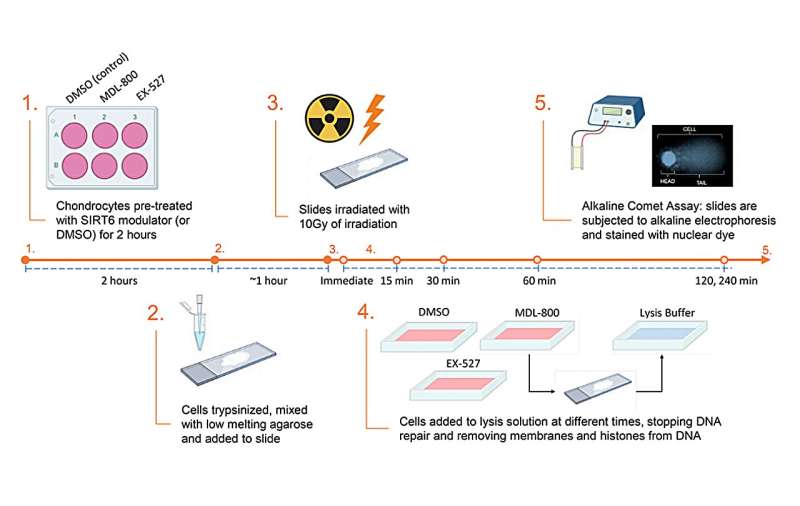This article has been reviewed according to Science X's editorial process and policies. Editors have highlighted the following attributes while ensuring the content's credibility:
fact-checked
proofread
Sirtuin 6 activation rescues the age-related decline in DNA damage repair in chondrocytes: Study

A new research paper titled "Sirtuin 6 activation rescues the age-related decline in DNA damage repair in primary human chondrocytes" has been published in Aging.
While advanced age is widely recognized as the greatest risk factor for osteoarthritis (OA), the biological mechanisms behind this connection remain unclear. Previous work has demonstrated that chondrocytes from older cadaveric donors have elevated levels of DNA damage as compared to chondrocytes from younger donors.
In this new study, researchers Michaela E. Copp, Jacqueline Shine, Hannon L. Brown, Kirti R. Nimmala, Oliver B. Hansen, Susan Chubinskaya, John A. Collins, Richard F. Loeser, and Brian O. Diekman from University of North Carolina at Chapel Hill, North Carolina State University, Rush University Medical Center, and Thomas Jefferson University aimed to determine whether a decline in DNA repair efficiency is one explanation for the accumulation of DNA damage with age, and to quantify the improvement in repair with activation of Sirtuin 6 (SIRT6).
The researchers write, "In this study, we use irradiation as an acute model of DNA damage to bring the level of damage to equivalent levels across chondrocytes from donors of various ages."
After acute damage with irradiation, DNA repair was shown to be more efficient in chondrocytes from young (≤45 years old) as compared to middle-aged (50–65 years old) or older (>70 years old) cadaveric donors. Activation of SIRT6 with MDL-800 improved the repair efficiency, while inhibition with EX-527 reduced the repair rate and increased the percentage of cells that retain high levels of damage.
In addition to affecting repair after acute damage, treating chondrocytes from older donors with MDL-800 for 48 hours significantly reduced the amount of baseline DNA damage. Chondrocytes isolated from the knees of mice between 4 months and 22 months of age revealed both an increase in DNA damage with aging and a decrease in DNA damage following MDL-800 treatment.
Lastly, treating murine cartilage explants with MDL-800 lowered the percentage of chondrocytes with high p16 promoter activity, which supports the concept that using SIRT6 activation to maintain low levels of DNA damage may prevent the initiation of senescence.
"In conclusion, the findings presented here support the hypothesis that the efficiency of DNA damage repair declines with age in chondrocytes and that SIRT6 activation improves repair both in response to an acute irradiation challenge and in the context of age-related damage accumulation," the researchers summarize.
"These results emphasize the critical role of SIRT6 in DNA repair and support further studies investigating the use of MDL-800 (or alternative SIRT6 activators) in mitigating senescence induction and ameliorating OA development."
More information: Michaela E. Copp et al, Sirtuin 6 activation rescues the age-related decline in DNA damage repair in primary human chondrocytes, Aging (2023). DOI: 10.18632/aging.205394


















